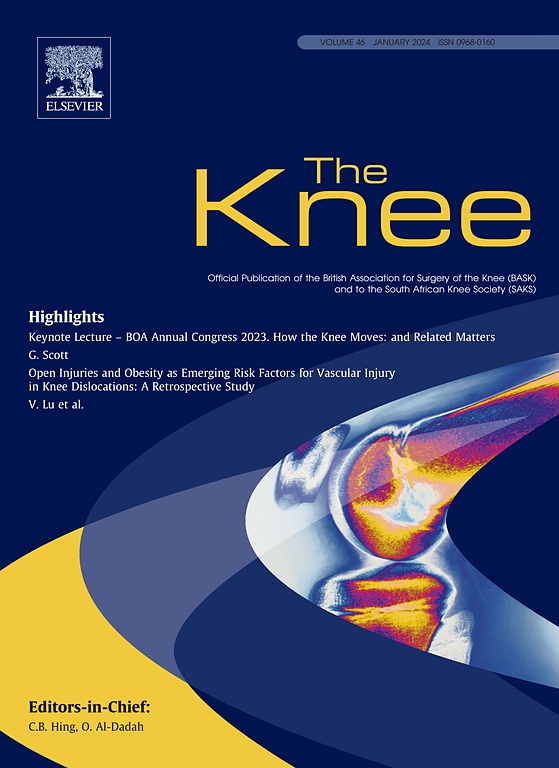
Single locked plate vs. dual buttress plating for bicondylar tibial plateau fractures

Single locked plate vs. dual buttress plating for bicondylar tibial plateau fractures
A comparison of lateral fixation versus dual plating for simple bicondylar fractures
Knee. 2015 Jun;22(3):225-9Did you know you're eligible to earn 0.5 CME credits for reading this report? Click Here
Synopsis
86 patients with bicondylar tibial plateau fracture with a relatively intact medial tibial condyle were randomized to receive surgical treatment with either a single lateral locking plate (LP) or dual buttress plates (DP). The purpose of this study was to compare clinical and radiographical outcomes between fixation methods over a minimum of 12 months postoperatively. While the incidence of delayed union was significantly lower in the LP group compared to the DP group, no patient experienced non-union. All other clinical, functional and radiographic outcomes were similar between groups, as well as the incidence of infection. Surgical parameters, such as operative time, blood loss, and hospital stay, were better in the LP group compared to the DP group.
Was the allocation sequence adequately generated?
Was allocation adequately concealed?
Blinding Treatment Providers: Was knowledge of the allocated interventions adequately prevented?
Blinding Outcome Assessors: Was knowledge of the allocated interventions adequately prevented?
Blinding Patients: Was knowledge of the allocated interventions adequately prevented?
Was loss to follow-up (missing outcome data) infrequent?
Are reports of the study free of suggestion of selective outcome reporting?
Were outcomes objective, patient-important and assessed in a manner to limit bias (ie. duplicate assessors, Independent assessors)?
Was the sample size sufficiently large to assure a balance of prognosis and sufficiently large number of outcome events?
Was investigator expertise/experience with both treatment and control techniques likely the same (ie.were criteria for surgeon participation/expertise provided)?
Yes = 1
Uncertain = 0.5
Not Relevant = 0
No = 0
The Reporting Criteria Assessment evaluates the transparency with which authors report the methodological and trial characteristics of the trial within the publication. The assessment is divided into five categories which are presented below.
3/4
Randomization
3/4
Outcome Measurements
4/4
Inclusion / Exclusion
4/4
Therapy Description
4/4
Statistics
Detsky AS, Naylor CD, O'Rourke K, McGeer AJ, L'Abbé KA. J Clin Epidemiol. 1992;45:255-65
The Fragility Index is a tool that aids in the interpretation of significant findings, providing a measure of strength for a result. The Fragility Index represents the number of consecutive events that need to be added to a dichotomous outcome to make the finding no longer significant. A small number represents a weaker finding and a large number represents a stronger finding.
Why was this study needed now?
Bicondylar tibial plateau fractures continue to present a challenge to orthopedic surgeons due to their complexity, often as a result of a motor vehicle accident. Plate fixation is often used in the management of such injuries. Dual buttress plate fixation has been cited as advantageous with respect to fixation stability, but concerns with this method include soft-tissue healing and periosteal blood supply. This has led to interest in the use of a single locking plate for fracture fixation, though there are concerns with reduction quality and stability with this fixation method, particularly in cases with severe comminution or unstable medial condyle. It is suggested in cases of a relatively intact medial condyle without comminution, single locking plate fixation may offer a viable alternative. This study sought to compare the efficacy of the described fixation techniques within these specific injuries.
What was the principal research question?
What is the efficacy of a single lateral locking plate compared to dual buttress plate fixation in the management of bicondylar tibial plateau fractures with a relatively intact medial condyle, as assessed up to 12 months postoperatively?
What were the important findings?
- The LP group demonstrated significantly shorter operative time (120 +/- 25min vs. 150 +/- 20min; p<0.05), lower blood loss (300 +/- 28mL vs. 420 +/- 35mL; p>0.05), and shorter length of hospital stay (12.7 +/- 4.3 days vs. 18.6 +/- 2.7 days; p<0.05) compared to the DP group. The amount of time form admission to surgery did not significantly differ between groups (9.6 +/- 3.2 days vs. 10.6 +/- 3.5 days).
- There were no cases of nonunion observed in either group. The rate of delayed union was significantly lower in the LP group, as compared to the DP group (LP: 0/41; DP: 7/44; p=0.023).
- There was no significant difference in mean time to union between the LP and DP group (13.2 +/- 2.0 days vs. 16.5 +/- 2.1 days).
- Rate of loss of alignment was 1/41 in the LP group and 0/44 in the DP group. Rate of loss of reduction was 1/41 in the LP group and 2/44 in the DP group.
- Two patients in the DP group developed superficial infection. No patient in either group developed deep infection.
- At 12 months, the LP and DP groups demonstrated similar HSS score (81.3 +/- 8.6 vs. 79.6 +/- 7.6) and knee range of motion (120.8 +/- 11.6deg vs. 115. 8 +/- 15.9deg).
What should I remember most?
In the fixation of bicondylar tibial plateau fractures with an intact medial condyle, a single locking plate was associated with significantly shorter operative time, lower blood loss, and shorter length of hospital stay when compared to dual buttress plate fixation. Comparable results between groups were observed for clinical, functional, and radiographical outcomes and complications when assessed over a minimum of 12 months postoperatively, with the exception of incidence of delayed union, which was significantly lower following single locking plating fixation.
How will this affect the care of my patients?
The results of this study suggest that in the particular case of bicondylar tibial plateau fractures with an intact medial condyle, a single locking plate may offer similar results to dual buttress plate fixation, while possibly being advantageous with respect to operating time and hospital stay. Further studies with larger sample sizes are required to verify the current results.
Learn about our AI Driven
High Impact Search Feature
Our AI driven High Impact metric calculates the impact an article will have by considering both the publishing journal and the content of the article itself. Built using the latest advances in natural language processing, OE High Impact predicts an article’s future number of citations better than impact factor alone.
Continue



 LOGIN
LOGIN

Join the Conversation
Please Login or Join to leave comments.